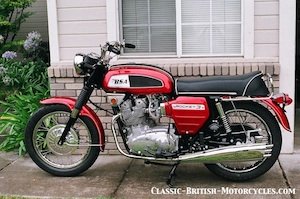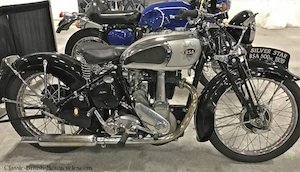BSA MOTORCYCLES RULE THE WORLD!
From the mid-1930’s through the early 1960’s, BSA was the world’s largest producer of motorcycles. But their motorcycle division was just one small corner of the gigantic BSA financial empire at that time. In fact, BSA was one of the largest companies in the world for many years. At the opening of the 1960s, they were successful, well-respected, flushed with cash, and poised for greatness. Instead, they stumbled their way into receivership and obscurity. A true pity.

ABOVE: BSA Motorcycles seminal model: This one is a 1954 BSA Gold Star.
BSA IS NUMBER ONE
As the 1950s came to a close, BSA Motorcycles was on top of the world. The BSA Gold Star was a mega hit, on the track & in showrooms, and the BSA A7 (500 twin) and A10 (650 twin) non-unit twins were solid sellers with a great reputation. BSA also owned Triumph, Ariel, Sunbeam & New Hudson, and this was just a small part of the BSA empire, which also included cars, buses, steel, heavy construction equipment, agricultural & industrial powerplants, machine tools, weapons, ammunition, military equipment, bicycles & more. They were a bona fide industrial giant, capable of accomplishing almost anything & in far better financial shape than just about anyone else in the motorcycle business. By 1970, the once-mighty BSA was broke & irrelevant as a motorcycle company. Even Triumph, the jewel in BSA’s crown, already on death’s door, was taken over by its workers in their failed attempt at independence. How the mighty fall.

ABOVE: The unit-construction equivalent of the pre-unit Gold Star, this 1966 441 Victor is actually a high-performance GP model.
IT’S ALL ABOUT THE MOTORCYCLES
Our emphasis here, however, is on the wonderful motorcycles that BSA Motorcycles did produce, despite all the politics & bad management. Great names like the BSA Gold Star, the A7 and A10, 441 Victor, the unit-construction A65, and the radical 3-cylinder Rocket 3 were awesome machines in their day. Despite this, its impossible not to notice or to comment on the strange way BSA Motorcycles had of doing things, which usually came down to “too little too late” more than anything else, plus a good dose of arrogance & inept management.

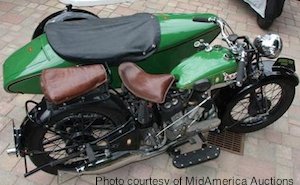
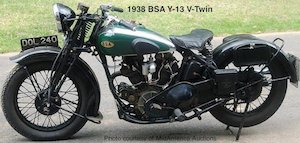

SWORDS TO PLOWSHARES
BSA, or Birmingham Small Arms, started out as a loose alliance of craftsmen in the Coventry area who teamed up to produce rifles for the English Army during the Crimean War (1854-56) in the days when firearms were painstakingly handcrafted by artisans. They soon realized that 2 things would be needed for their survival: Modern production techniques & a broader product line. By 1884 they were building bicycles, a new thing at the time, and all the rage. From there they naturally graduated up to motorized bicycles then true motorcycles by 1905.
EARLY EXPANSION
They expanded the product line & refined their methods. This was a time when most motorcycle manufacturers were practically ‘cottage industries’ that relied on parts brought in from elsewhere (ie: engines, gearboxes, etc.), but BSA by this time was already so big that it was making virtually everything for its bikes in-house.
WAR IS GOOD FOR BUSINESS
World War I was good for BSA Motorcycles. Not only did they sell lots of motorcycles to the British Army & others, but by war’s end, they were producing 10,000 Lee-Enfield .303 rifles PER WEEK! They also built 145,000 Lewis Guns (early machine guns) & much more. After the war, the work of building BSA motorcycles continued at a rapid pace. BSA quickly built a reputation for building reliable, rugged workhorse motorcycles, not necessarily the fastest.
POST WAR MARKET
At the time, most motorcycles were single cylinders, most with side valves (flat head) and BSA was no exception. By by 1926, they released a brand new OHV (OverHead Valve) 493cc single called the “Sloper” because of the sloped angle of the cylinder. It was a huge success.

ABOVE: This 1938 BSA Y13 had 749cc and was the last of a long line of V-twins designed for sidecar duty.
BSA V-TWINS
Side cars were a large part of the motorcycle market in those days, many English families relying on them as their primary means of transport for the whole family. Sidecar rigs needed more torque than most singles could offer, so in 1920, BSA introduced the first of their line of V-twins, this one a 986cc model with a 50-degree V (50-degrees? Why not 45?). The V-twins continued through the 1930s in various sizes and V-angles.
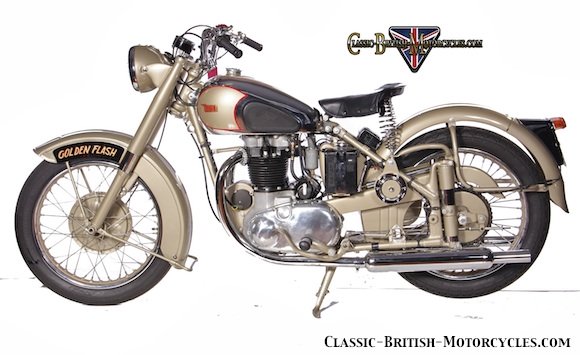
ABOVE: The Golden Flash was BSA’s first 650. This one is a 1951. Note the iron head and plunger-type rear suspension.
ANOTHER VERTICAL TWIN
Of course the introduction of the Triumph 500 Speed Twin in 1937 changed everything. No one had ever thought of doing a twin quite like this before. It was narrow & light like a single (so it could fit in a single-frame), but had the power of a V-twin. BSA Motorcycles quickly started developing their own 500 vertical twin, but alas the outbreak of WWII postponed this. BSA spent the war producing over 130,000 W20 side valve motorcycles for the Allied Forces, along with lots of other stuff. And again, they emerged from the war stronger & richer than ever.

ABOVE: This 1959 650 Rocket A10 was nearly the pinnacle of pre-unit BSA Twin development. Unit construction would replace it in 1962.
THE GOLDEN AGE
This was really the Golden Age for BSA motorcycles. In 1946, the introduced their own 500 vertical twin, the BSA A7, designed by genius Val Page, and just 4 years later “stretched” to a 650 in the BSA A10. Development continued on big singles also & soon the Gold Star was reborn (a few early Gold Stars were built before the War), perhaps the most successful motorcycle in its day. Throughout the 1950s, Gold Stars were winning races & selling like hotcakes. The BSA A7 and A10s were also doing well & were well-respected for their smoothness & reliability.
INDUSTRIAL GIANT
BSA acquired Triumph in 1951 in a backroom deal with Ariel Motorcycles-owner Jack Sangster, who came along with the package. He sat on BSAs Board of Directors until the early 1960s & oversaw the stripping & selling-off of BSAs assets. By the time he retired in the early 1960s, the once-mighty BSA industrial giant was a pitiful shadow of its former self. Not only were the money & all the assets gone, but much of the talent must have left also, because BSA Motorcycles made a string of blunders that hastened its trip to the grave.

ABOVE: The quintessential BSA, this 1970 A65 Lightning was the final year before the all-new Oil-in-Frame bikes arrived.
UNCERTAINTY IN THE 60’s
With the BSA A7 (500) and A10 (650) vertical twins doing well, they decided to completely redesign them into the ‘new’ unit construction mold, like Triumph had done with its 500 twin in 1959. So, in 1962, BSA introduced its all new BSA A50 (500) & A65 (650) unit-construction twins. Everyone yawned. They were ugly, had vibration problems like never before & they never sold well again (one year later, Triumph went unit-construction with its 650 twin & it was a major hit). Then, in 1963, BSA killed off its best-seller, the Gold Star, without a suitable replacement. It spent the rest of the 1960s struggling with an out-of-touch product line & never really addressed the problems. They were styled poorly, to begin with. But BSA needed to invest in new technologies if it was to survive. It needed lightweight 2-strokes to compete with all the new Enduro models pouring out of Japan. What did we get? The BSA Bantam, a hopelessly outdated bike that looked like it belonged in the 1950s. Imagine BSA thinking that the 1968 Bantam would sell against the great 2-stroke off-road bikes being built & sold by the shipload by Yamaha, Kawasaki and Suzuki.

ABOVE: 1969 BSA Rocket 3, 750cc triple. Automotive design firm Ogle styled the bikes very poorly, with “Shoebox” tank, slab-like side covers & laughable “Ray Gun” mufflers. It hurt sales badly.
BSA & TRIUMPH TRIPLES
Pride also got in the way, as many BSA execs resented Triumph’s success & made decisions accordingly. Well ahead of the market for a change, development had started on a 750cc triple as early as 1963 (as a Triumph) and by 1965 there were prototypes running around. The original idea was that this new 3-cylinder would be the replacement for the aging Triumph 650 vertical twin line (ie: Bonneville and TR6), and it would be called the Triumph Trident. But, true to form, BSA couldn’t make a decision and so the project stalled…until word came down in 1967 that Honda was soon to introduce their ground-breaking 750-Four. Suddenly BSA came to life and the project was pushed through, but not without a good dose of “BSA logic”, or lack thereof. If Triumph was going to get this cool new triple, then BSA Motorcycles should have one too. But not something sensible like a simple re-badging. No, BSA wanted their own unique bike! So, a new engine had to be redesigned and tooled-up, the same as the Trident‘s, an OHV inline 3-cylinder 750, but with the top end canted forward 12-degrees. Then they wanted a new frame, more like the BSA duplex frames than the Triumph’s single-downtube frame. This extra work delayed introduction of both the BSA Rocket 3 and the Triumph Trident such that they only beat the Honda 750-Four to market by a few months, even though they had started on it over 5 years earlier! And the styling!! Yuck! Instead of making them look like other Triumph and BSA motorcycles, they hired an automotive stylist called Ogle to style the bikes unlike anything else on the market. They certainly got that part right. The boxy tank and silly Ray Gun mufflers were a joke and hurt sales badly.

ABOVE: 1971 A65 Lightning with oil-bearing frame. Actually a very handsome machine. Frames came painted light dove gray from the factory in 1971, but was switched back to black for 1972.
OIL-IN-FRAME FISACO
Another huge blunder by BSA Motorcycles was to take Triumph’s very successful 650 twin line & screw it all up with a new oil-bearing frame (that no one asked for & few liked), turning that one-time top-seller into yet another marketing failure. BSA also stuffed their own 650 vertical twin engines into the oil-bearing frames & sold even fewer bikes this way than Triumph. By 1972, there were no more BSA Motorcycles. They tried their best to do the same for Triumph, but the Triumph workers revolted when they heard that BSA was closing the Meriden plant. They took over the plant & held it hostage for 1-1/2 years until they brokered a deal to buy the ailing Triumph Motorcycles as the employee-owned Meriden Co-operative, but there was no saving Triumph. They limped along until 1983, but the handwriting was on the wall.
WHAT HAPPENED?
Looking back at history, with the onslaught of high-volume, low-cost, high-quality & high-tech motorcycles pouring out of Japan, BSA Motorcycles, Triumph and the entire British motorcycle industry would have needed to completely retool and more importantly, change their thinking, in the very early 1960s to have been ahead of the curve. Interestingly enough, Edward Turner, genius creator of the Triumph Speed Twin and the Ariel Square Four, traveled to Japan in 1960, spending 8 weeks there observing Japanese design and manufacturing methods. At that time, Japan was turning out nearly a million motorcycles a year! All of Britain was producing maybe one-tenth that number. What were Turner’s conclusions? Who knows, because upon his return to England, it was back to business as usual, nothing changed. By this time, Turner was on the board at BSA Motorcycles & like the rest of the company, he chose to ignore the changing times, preferring instead to live in the past & continue to rehash old designs rather than come up with fresh ones. In fact, it is said that Turner ruled with an iron hand & didn’t allow any other designs to compete with his own, preferring to continually develop his ancient vertical twin, rather than start with fresh, modern designs.
Financial problems can happen to any company, or any motorcycle owner for that matter, even when they least expect it. Title Max can help with unexpected expenses by offering a Title Max motorcycle title loan based on a motorcycle’s value.
A NEW LIFE FOR BSA MOTORCYCLES?
The big news is the Indian tractor giant Mahindra purchased the BSA brand in October 2016 with big plans to start producing BSA motorcycles again in India. Mahindra has been producing small 2-stroke commuter bikes and scooters for years, so this is their play to move upmarket. They certainly have the money, the technical and production capacity and the market reach to make it work. But what about the bikes? No one knows for sure yet, but we just recently acquired some drawings by a designer who worked with BSA in the early stages of planning. Get the whole story on our page about the exciting new BSA-Mahindra. So, there is life after death for BSA. Hopefully the new bikes will do justice to this great and hallowed name.
Whether your British bike is classic or modern, and whether you ride it or show it, keeping it looking good is a continuous process. Many traditional car care products and detailing methods work great on bikes. Check out CarCareNinja.com for some great detailing tips and products. Keep up with it, do it often, don’t let the road grime settle on your bike too long. Wipe it down every time you ride it, with the proper products, of course.
BSA Motorcycles MODEL-BY-MODEL
GOLD STAR
350cc: B32, BB32
500cc: M24, B34, BB34, DB34, DBD34, YB34, ZB34
The hand-built high-performance singles were among the fastest motorcycles in the world in the 1950s, dominating Isle of Man Clubman TTs & ISDT.
A50 and A65
500cc: A50
650cc: A65
BSA’s non-unit A7 (500) & A10 (650) went Unit Construction in 1962 & became the A50 (500) & A65 (650). The so-called ‘improvement’ hurt sales & BSA’s image. Neither model ever sold very well.
1971 A70 Lightning 750
BSA’s ultra-rare A70 was the 750 version of the A65 with an 11mm increase in stroke. Only 202 were built as BSA neared the end.
A7
1947-1962
495cc OHV Vertical Twin
BSA’s first vertical twin had to wait for the War to end before launching in 1947 with rigid frame & telescopic forks. Plunger came in 1950 & swingarm in 1954. Continual improvements were made to engine, gearbox, frame & running gear. Finally replaced by unit-construction A50 in 1963.
A10 1950-1962
646cc OHV Vertical Twin
In 1950, BSA bored & stroked the A7 500 out to 650, creating the BSA A10. The A10 continually improved until replaced by the unit-construction A65 in 1963. Ironically, the ‘new-and-improved’ A65 never sold as well as the pre-unit A10.
ROCKET 3
750cc: A75
BSA’s 3-cylinder superbike, built by tripling 3 BSA 250 singles, sister bike to the Triumph Trident, but with forward-canted cylinders & a BSA-specific frame. Boxy styling & wierd Ray Gun mufflers hurt sales + Honda 750-4 came out soon after.
B50 500cc Singles
BSA’s big unit-construction 500cc single was built for just 3 model years, from 1971 through 1973, BSA’s last year as a motorcycle producer. Street, off-road and MX versions.
BANTAM
D1: 123cc, 1948-63
D3: 148cc, 1954-57
D5: 172cc, 1958
D7: 172cc, 1959-66
D10: 172cc, 1966-67
D14: 172cc, 1968
D175: 172cc, 1969-71
BSA’s 2-stroke commuter.
M20 MILITARY MOTORCYCLE
500cc Side-Valve air-cooled single
BSA built 126,000 M20 during WW2 & they served well into the 60s.
The Val Page-designed 350 & 500 singles that formed the foundation of BSA’s entire single-cylinder lineup for years to come.
BLUE STAR
249cc, 1932-1936
349cc, 1932-1936
499cc, 1932-1936
BSA’s first true long-distance bike, reliable (for the day) with reasonable comfort. Replaced in ’37 by the Empire Star, which evolved into the Gold Star.

1953 BSA B33
This fully-restored 500 single is one of the last BSA’s with plunger rear suspension.
That’s right! BSA is back…sort of. Mahindra just bought the name & plans to build lots of new BSAs starting in 2019, bound for the US & Europe. We get a behind-the-scenes peak at the new bikes.
Check out these BSA BOOKS
BSA Motorcycles: The Final Evolution
The BSA Gold Star: Motorcycle History
Illustrated Bsa Buyer’s Guide (Motorbooks International Illustrated Buyer’s Guide)
BSA Unit Singles: The Complete Story including the Triumph Derivatives
Bsa Motor Cycles: Since 1950 (British Motor cycles since 1950)
BSA 500 & 650 Twins: The Essential Buyer’s Guide
How to Restore Triumph Trident T150/T160 & BSA Rocket III: YOUR step-by-step colour illustrated guide to complete restoration (Enthusiast’s Restoration Manual)
For more like these, visit our BSA BOOK STORE
 |
PLEASE BUY MY NEW E-BOOK HERE 12 Chapters & over 100 original photos. My best work yet. ONLY $4.99! Thank you, Andy Tallone, your humble authorClick here to buy now: The Random History of Classic British Motorcycles, Volume 1 |









